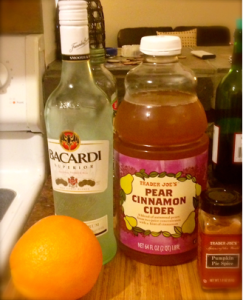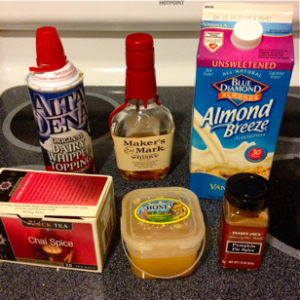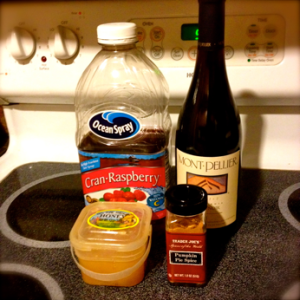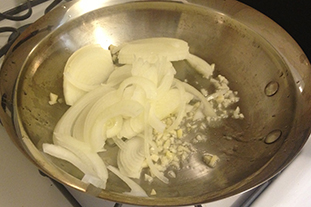Nutritionist and registered dietitian Emily Bostrom and her cousin Alyssa Kurtzman share a healthy obsession with food, a set of grandparents, and many nutrition-related conversations, often late at night via G-Chat or anxious text message exchange. They sat down together to discuss…
Heavy Cream vs. Half & Half
Alyssa: Last weekend, I followed this Jacques Pepin recipe for a butternut squash gratin, except I used half and half because I couldn’t bring myself to use heavy cream. And it came out all weird and curdle-y! Why did the cream not mesh into the gratin like restaurant gratins? And what was that liquid in the bottom of the pan? Was the gratin safe to eat? And by that I mean I still ate all of it. And am I going to die now.
Emily: First things first—I believe that it was very safe to eat (as long as it didn’t sit out on your counter between 40° and 140° F for more than two hours). Also, since you’re not reporting any awful symptoms, I’m guessing it sat pretty well.
So, there are few things to consider when making a dish that relies on heavy cream. First of all, should you really be cutting calories when you’re making a seasonal dish you only make once a year? (I personally don’t believe in “diet” holiday food.) So my first recommendation would be to eat a salad for lunch, and use heavy cream in the recipe. Now, as a dietitian, I too experience the guilt associated with even entering the heavy cream section of the dairy refrigerator. Too often, when I buy ingredients like heavy cream or boxed macaroni and cheese–
Alyssa: Judge.
Emily: It’s ORGANIC, okay; I race out of the store before the food police can find me and take away my credentials. But, it’s okay! Go for it. Just don’t eat the leftovers every day after that for a week.
Anyway, back to the curdling issue. When you add heat (like in the oven) or acid (like that salted squash) to milk, you can cause it to separate into its components: curds (solids) and whey (watery liquid you found in the bottom of your pan). Unless you’re making your gratin for Little Miss Muffet, you probably want to prevent this from happening. When you cook milk in this whey *ahem, nutrition joke*, there are a few things that help to keep it from separating, or curdling. First, fat helps milk maintain its texture, so that heavy cream might actually be in that recipe for a reason (those restaurant gratins are so creamy because of the cream). If you’re really motivated to keep the recipe low-fat for some reason, like you’re making this for your grandma with heart disease or it’s the day before your annual lipid panel, then there are a few more ways to improve your gratin’s texture with a lower-fat milk in the recipe.
Starch is another way to improve the final product, so making a roux (flour and fat mixture) can really help that gratin stay creamy and not clumpy. Just add a teaspoon of all-purpose flour for each cup of milk (or half and half) in the recipe. Also, making sure not to rinse the sliced squash (or potatoes, if you’re doing that version) would help maintain that naturally occurring starch for the recipe. Finally, the fresher the milk, the less likely it is to curdle, so hike out to the farm and collect some fresh half and half for your delicious butternut squash gratin. Also, invite me over.
Alyssa: Sorry. I wasn’t kidding about having eaten all of it.
Quest for the Best Bean
Alyssa: I’m pretty sure all beans are healthy, but are some healthier than others? What is the best bean? Come on, we know you know. Stop hiding this information from us.
Emily: Okay, asking me to pick the healthiest bean is like asking a mother to pick her favorite kid! (As an only child, though, I’ve never felt uncomfortable asking this question… I’m sure you’re Aunt W. and Uncle S.’s favorite daughter…)
Alyssa: I am, but when our dog Misha was still alive, they told me it was a toss-up.
Emily: Well, obviously. You could never compete with those giant ears.
As you said, all kinds of beans really are healthy, and have some things in common. Most all beans are rich in fiber, folate and B-vitamins, and many contain iron, which we like. Also, beans are a pretty good source of protein, especially as a meat-free source for our veg friends. Finally, beans (especially dried ones) are cheap, which is important when the fancy free-range, organic, fair-trade, locally grown truffle salt you’re sprinkling on them is $35.00/oz.
But, since you insist on finding out the best bean, I’ll just summarize the benefits of beans into this little chart so you can pick for yourself.
| Rich in… | Special Feature! | Use in… | |
| Black Beans | Fiber, Folate, Iron, Magnesium | Anthocyanins, an antioxidant that makes them extra heart healthy | Salads, Burgers, Soups or dips! |
| Soy Beans | Calcium, Iron, Potassium | 9 Essential Amino Acids! A fantastic plant protein. | Hummus, edamame (steamed) or stir fried |
| Chick Peas | Fiber, Folate, Potassium, Magnesium | The Most Common Legume in the World! | Creamy hummus, crunchy and roasted or mixed into warm falafel. |
| Lima Beans | Fiber, Potassium | Cultivated to support the Aztec and Incan protein-deficient diet | With corn as Succotash or stewed on their own. |
| Black-Eyed Peas | Fiber, Magnesium, Zinc | A symbol of good luck in the new year! | In fritters, stews, salads and with rice. |
[Source: Eat Right]
A Holiday Party Hangover Cure
Alyssa: Holiday party hangover cure: go.
Emily: Okay, honestly, what is every company’s deal with holiday parties on weekdays? Is it to ensure that nothing gets done the next day at work? To make people feel less comfortable drinking liberally off the company tab? Whatever the reason, I just don’t like it. Weeknights are for cleaning your bathroom and eating sensibly and watching the last three episodes of the Real Housewives of Beverly Hills. Everyone knows that.
Alyssa: Apparently one of the new cast members is a witch, btw???
Emily: Where do they find these people?! Anyway, since companies insist on weeknight party time, here are a few evidence-based ways to get your ass to work the next morning:
- Much of that miserable morning is due to dehydration and electrolyte imbalance. So the first, most obvious hangover fix is something liquid with electrolytes, plus a little bit of sugar to get those much needed electrolytes into our tissues. What’s rich in electrolytes and fluid? Coconut water, watered-down Gatorade or Powerade (these sports drinks have just more sugar than we need), or a little bit of 100% orange juice should do the trick, and then just transition to water. Hydrate ‘til you just can’t stand getting up from your desk to pee anymore, and then you’ll know that you’ve done a good job.
- A cup of a caffeinated beverage can really make you feel more alert, and research shows that it can help improve your recovery after a long night of eggnog. Contrary to popular belief (including supporters like my mom and Dr. Oz), the research shows that 400mg of caffeine or less per day has no effect on your hydration. That means that about 3 cups of coffee are hydrating rather than dehydrating. Good news for those of us who are rolling into work twenty minutes late with last night’s mascara on.
- So, here’s a fun one: asparagus. Maybe the party had asparagus wrapped in prosciutto as hors d’oeuvres, and there are some left in the office fridge! That’s a double whammy with the salty ham (electrolytes!) and enzymes found in asparagus that have been shown to speed up the processing of alcohol in our bodies. SO, munch on some of my absolute-favorite-vegetables-of-all-time and feel fantastic!
Alyssa: Up top.
Emily Bostrom, RD, is a Registered Dietitian with degrees from Rutgers University and the University of Medicine and Dentistry of New Jersey, who eats, cooks and thinks about food. You can also find her singing loudly in the car and at http://www.emilybostrom.
Alyssa Kurtzman is a Content Manager at @CLIPTAMATIC and works on the UE social media staff. Life mantra: It’s never too hot for soup. @KURTZMANIA

Photo by Meaghan Morrison





































